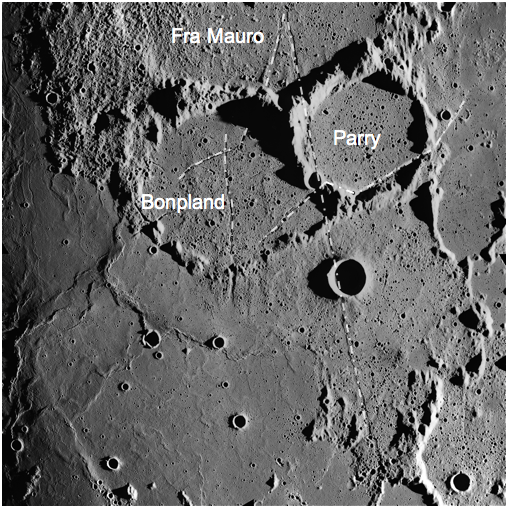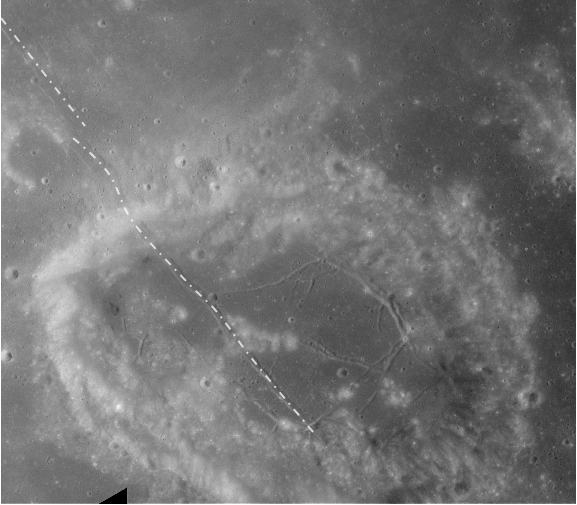
| Project Home | About the Scans | Browse Gallery | Image Map | Support Data | Resources | Ephemeris |
Featured Image - 2/17/2009
Linear Graben
Linear rilles, or graben, are significantly different in form and origin from sinuous rilles. The linear features form when the lunar crust is pulled apart and two opposite-facing faults form a graben. In contrast, sinuous rilles are formed by lava flows cutting their way through the lunar crust. The width of these grabens can range from a few meters to kilometers across. Grabens cut across mare basalts, highlands, and impact craters, reflecting the orientation of stresses in the lunar crust. The crosscutting relations between the grabens, the crustal material, and the landforms they deform determine a relative order of events.
Figure 1. Apollo 16 metric photograph showing crater Goclenius on the western edge of Mare Fecunditatus. (-10.0° S, 45.0° E). Sun elevation is 44°. The dotted white line represents the path of Rimae Goclenius. Other smaller troughs are visible in the smooth floor of Goclenius. (Apollo Image AS16-M-0139 [NASA/JSC/Arizona State University])
It is fairly common for grabens to form due to crustal readjustment after impacts. One example is Rimae Goclenius, shown here in AS16-M-0139. The graben cuts through crater Goclenius and continues on through the mare towards the northwest, in the direction of crater Gutenberg. Goclenius is an older crater, with a highly eroded rim and an oblong shape. The interior is partially flooded with mare basalt, and displays a complex network of linear troughs, each about 1 kilometer wide. Some of the troughs intersect at right angles.
Rimae Parry, shown below in AS16-M-16867, is another example of a graben, this time in a more exotic setting: the intersection of three impact craters south of the Apollo 14 landing site, Fra Mauro, Bonpland, and Parry, which form a mountain rise. The floors of the craters flooded with lava, creating a smooth surface which was subsequently peppered with smaller impact craters. Since the grabens extend across the emplaced lava as well as the large crater rims, we know that the grabens postdate the lava and the large craters.
The upcoming Lunar Reconnaissance Orbiter Camera will collect high-resolution images (50/cm pixel) of tectonic features like grabens, also known as linear rilles, which will help lunar scientists to better understand lunar structural geology.

Figure 2. Apollo 16 metric photograph showing Rimae Parry and craters Bonpland, Fra Mauro, and Parry. The dotted white lines highlight the paths of the grabens. To the southeast is the small crater Tolansky. (Apollo Image AS16-M-1687 [NASA/JSC/Arizona State University])
Sources:
Rilles, Ridges, and Domes - Clues to Maria History. (1965) Quaide, W. Icarus 4, 374-389.
Apollo Over the Moon: A View from Orbit (1978) H. Masursky, G.W. Colton, F. El-Baz, eds. NASA SP-362. https://history.nasa.gov/SP-362/contents.htm

|
|
Space Exploration Resources |
|
 LPI LPI
|
